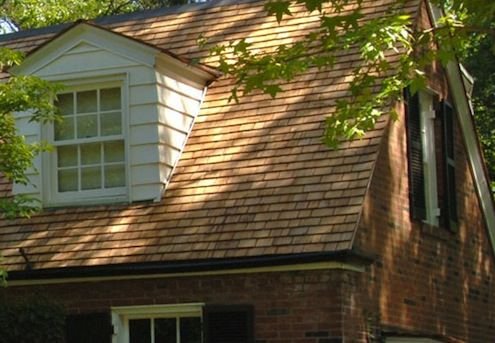If you are a homeowner in need of a roof replacement, you may be wondering what kind of roofing material to choose. There are many options available, each with its own advantages and disadvantages.
The type of roofing material you select can have a significant impact on your investment, as it can affect the lifespan, appearance, performance, and cost of your roof. In this post, we will explore the strengths and weaknesses of some of the most popular roofing materials homeowners prefer.

Expected Roofing Material Lifespans
One of the factors to consider when choosing a roofing material is its longevity. How long do you want your roof to last? How often are you willing to replace or repair it? The lifespan of a roofing material depends on various factors, such as the quality of installation, the climate conditions, and the maintenance level. Here are some approximate lifespans of different roofing materials, which you should keep in mind when consulting with Roof Replacement Services:
● Asphalt 3-Tab Shingles: 20 years
● Asphalt Architectural Shingles: 30 to 50 years
● Wood Shingles: 20 years
● Metal Roofs: 40 to 80 years
● Slate Shingles, Concrete Tile, and Clay Tiles: 60 to 150 years
As you can see, some roofing materials can last much longer than others, but they may also have higher upfront costs or other drawbacks. Let’s take a closer look at the pros and cons of each roofing material.
Asphalt Shingle Roofs
Asphalt shingles are the most common roofing material in North America. They are made of an asphalt/fiberglass base shingle covered with protective granules that add color and durability. There are two types of asphalt shingles: 3-tab shingles and architectural shingles. 3-tab shingles are flat and uniform, while architectural shingles have an extra layer or tab that creates a dimensional look.

Advantages of Asphalt Shingle Roofs
Asphalt shingle roofs are known for their cost-effectiveness. On average, you can expect to spend between $1.50 and $5.50 per square foot for standard asphalt shingle roofing. If you opt for architectural asphalt shingles, you’ll find them available at a higher price range, typically falling between $22 and $28 per square foot.
Asphalt shingle roofs are easy to install and repair. They can be applied directly over old shingles, providing the roof deck is in good condition.
Asphalt shingle roofs are classified as Class A fire-resistant, capable of enduring a fire for as long as two hours. In regions prone to wildfires, it’s advisable to consult your roofing contractor about alternative roofing materials, as there are many options that may outperform asphalt shingles in such conditions.
Asphalt shingle roofs are available in a wide range of colors, styles, and textures to suit any architectural style.
Disadvantages of Asphalt Shingle Roofs
Asphalt shingle roofs have the shortest lifespan of the roofing materials mentioned in this post. An asphalt shingle roof should last 15 to 30 years, but factors such as weather, ventilation, and quality can affect its durability. Other roofing materials can last 50 years or more.
Asphalt shingle roofs are vulnerable to strong winds, heat, hail, and storm damage. They can curl, crack, fade, or lose granules over time. They may also develop algae or moss growth in humid or shady areas.
Asphalt shingle roofs could be more environmentally friendly. They are made from petroleum-based products that produce greenhouse gas emissions during manufacturing and disposal. While asphalt shingles are recyclable and often used in pavement, they still contribute to landfill waste.
Considering installing asphalt shingles? Be sure to check out our GAF product range
Wood Roofs
Wood roofs have been used for centuries and are still popular today. They are made from natural wood materials, such as cedar, redwood, or pine. They can be either shingles or shakes. Shingles are machine-cut and have a smooth surface, while shakes are hand-split and have a rough texture. When considering wood roofing, it’s essential to consult with Roof replacement services to ensure you make an informed decision about this traditional and visually appealing option.

Advantages of Wood (cedar) Roofs
Cedar roofs have a long lifespan if properly maintained. They can last up to 30 years or more in moderate climates.
Wood roofs have a natural beauty and charm that can enhance any home style. They can also age gracefully and develop a silver-gray patina over time.
Wood roofs are eco-friendly as they are made from renewable and biodegradable resources. They also have high insulation value and can reduce energy consumption.
Disadvantages of Wood Roofs
Wood roofs are expensive compared to other roofing materials. The average cost of wood roofing is $6.50 to $11 per square foot.
Wood roofs require regular maintenance and treatment to prevent rot, insects, mold, and fire hazards. They may also warp or split due to moisture or temperature changes.
Wood roofs are not suitable for all climates. They can perform poorly in areas with high humidity, rainfall, or fire risk. They may also be prohibited by some local building codes or homeowners associations.
Are you thinking about a cedar roof? Be sure to check out our range of North Shore Prime shingles
Metal roofs
Metal roofs are a type of roofing material that is made of metal panels or tiles. They have some advantages and disadvantages compared to other roofing materials, such as asphalt shingles, wood shingles, or slate tiles. Here are some of the main pros and cons of metal roofs:
Advantages of Metal Roofs
Metal roofs are durable and long-lasting. They can resist fire, wind, hail, and corrosion better than most other roofing materials. They can last up to 70 years or more, while asphalt shingles typically last 15 to 30 years.

Metal roofs are energy-efficient and eco-friendly. They can reflect solar heat and reduce cooling costs by up to 40%23. They are also made of recycled materials and can be recycled at the end of their life. They can be installed over existing roofs, which reduces waste.
Metal roofs are versatile and attractive. They come in various colors, styles, and textures to suit any architectural style. They can mimic the look of shingles, shakes, tiles, or panels. They can also enhance the curb appeal and value of your home.
Disadvantages of Metal Roofs
Metal roofs are expensive and difficult to install. They can cost two to three times more than asphalt shingles. They also require specialized tools and skills to install properly. They may not be compatible with some roof structures or local building codes.
Metal roofs are noisy and prone to denting. They can amplify the sound of rain, hail, or wind, which can be annoying or disturbing for some homeowners. They can also dent or scratch easily from falling branches, debris, or hail.
Metal roofs are susceptible to expansion and contraction. They can expand or contract due to temperature changes, which can cause loosening, cracking, or leaking of the panels or fasteners. They may also require periodic maintenance and inspection to prevent these issues
A metal roof? The only right choice is VMZINC with installation by A.B. Edward!
Slate roofing
Slate roofing is a type of roofing material that is made from natural stone that is cut and shaped into thin pieces. Slate roofing has some advantages and disadvantages that you should consider before choosing it for your home.
Advantages of Slate Roofing
Slate roofing is very durable and long-lasting. It can resist fire, wind, hail, and corrosion better than most other roofing materials. It can last up to 200 years or more, while asphalt shingles typically last 15 to 30 years.

Slate roofing is very attractive and elegant. It has a natural beauty and charm that can enhance any home style. It can also age gracefully and develop a silver-gray patina over time. Slate roofing comes in various colors, styles, and textures to suit your preference.
Slate roofing is eco-friendly and recyclable. It is made from 100% natural stone that does not produce any waste or emissions. It can also be recycled at the end of its life. This type of roofing can reduce your energy consumption by reflecting solar heat and keeping your home cool in the summer.
Disadvantages of Slate Roofing
Slate roofing is very expensive and difficult to install. It can cost two to three times more than asphalt shingles. It also requires specialized tools and skills to install properly. It may not be compatible with some roof structures or local building codes.
Slate roofing is very heavy and brittle. It can weigh up to 1,500 pounds per square (100 square feet), which can put a lot of stress on your roof structure. It can also break or crack easily from falling branches, debris, or hail. You may need to replace damaged tiles periodically.
Slate roofing is not suitable for all climates. It can perform poorly in areas with high humidity, rainfall, or freeze-thaw cycles. It may also fade or discolor over time due to exposure to sunlight or chemicals.
Natural slate? The only right choice is CUPA
Synthetic roofing materials
Synthetic roofing materials are man-made alternatives to natural materials, such as slate or cedar shake. They are designed to mimic the appearance and performance of these materials but with some advantages and disadvantages.
Advantages of synthetic roofing materials
Synthetic roofing materials are more resistant to wear and tear, cracking, fading, and fire than natural materials. They can last up to 50 years or more with proper maintenance.

Synthetic roofing materials are generally cheaper than natural materials, both in terms of installation and maintenance. They can also help reduce energy costs by reflecting heat and providing insulation.
Synthetic roofing materials come in a variety of colors, styles, and textures to suit different architectural preferences. They can also be installed on different types of roofs, such as steep or low slopes.
Disadvantages of synthetic roofing materials
Synthetic roofing materials are made from petroleum-based products or other non-renewable resources, which can contribute to pollution and greenhouse gas emissions. They are also not biodegradable, which means they can end up in landfills for a long time. Synthetic roofing materials may not perform well in extreme temperatures or high winds. They can expand and contract due to thermal changes, which can cause leaks or damage. They can also be blown off by strong gusts of wind.
When it comes to synthetic shakes or tiles, the best solution is DaVinci Roofscapes!

